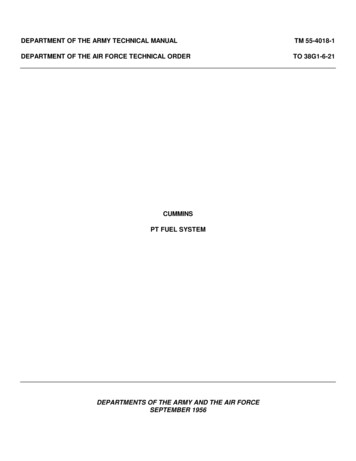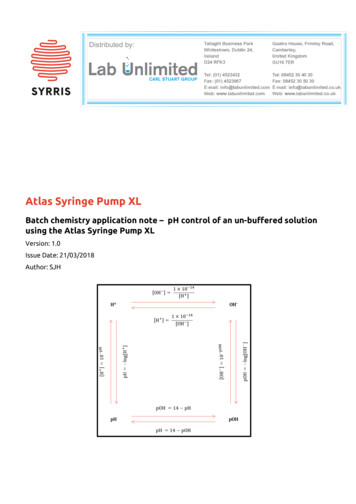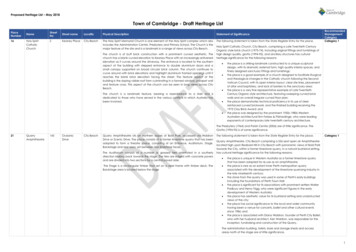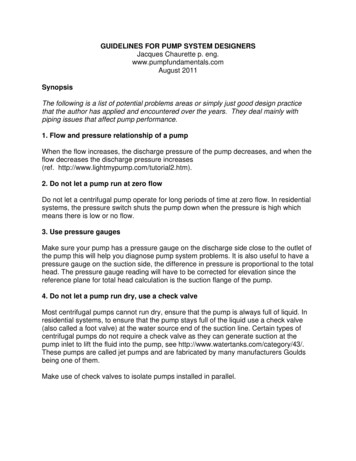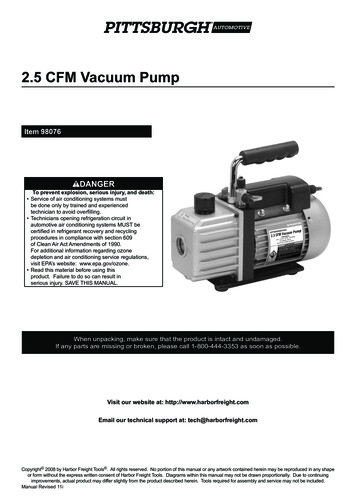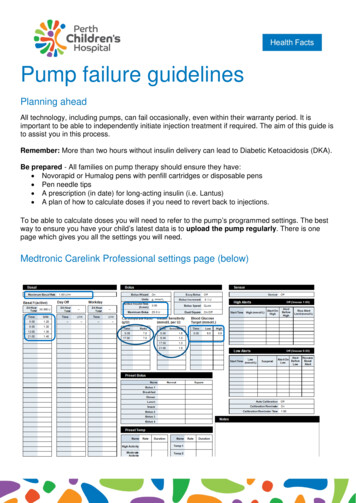
Transcription
Pump failure guidelinesPlanning aheadAll technology, including pumps, can fail occasionally, even within their warranty period. It isimportant to be able to independently initiate injection treatment if required. The aim of this guide isto assist you in this process.Remember: More than two hours without insulin delivery can lead to Diabetic Ketoacidosis (DKA).Be prepared - All families on pump therapy should ensure they have: Novorapid or Humalog pens with penfill cartridges or disposable pens Pen needle tips A prescription (in date) for long-acting insulin (i.e. Lantus) A plan of how to calculate doses if you need to revert back to injections.To be able to calculate doses you will need to refer to the pump’s programmed settings. The bestway to ensure you have your child’s latest data is to upload the pump regularly. There is onepage which gives you all the settings you will need.Medtronic Carelink Professional settings page (below)
Animas settings/rates page (below)Settings will be required to be able to calculate injection doses, and to enter into a replacementpump if needed.It is worth spending the time on the phone to the pump company’s helpline to enable uploading ofthe pump.*The green circles highlight the ICR and ISF you can use for injection doses if the pump fails. Theblue rectangles highlight additional settings required for when you need to reprogram areplacement pump.You will need to know:1. Current Insulin to Carbohydrate Ratio (ICR) – there may be multiple at different times ofthe day2. Current Insulin Sensitivity Factor (ISF) – there may be multiple at different times of theday3. 24 hour basal total dose.
Calculating your insulin dose: Your Lantus dose should be equal to your 24 hour basal total (round to the nearest wholenumber) and is to be given at the same time every day.If your pump screen is still working, you may be able to use it to calculate how much insulinto give as a rapid-acting insulin bolus by entering in the current Blood Glucose Level (BGL)and carbohydrate amount if eating, and giving the calculated dose via injection.If your pump screen is not working, doses can be manually calculated as below:To calculate insulin dose for carbs1. Check to see what the ICR is setat for the current time of the day2. Divide carbohydrate amount to beeaten by ICRE.g. I am about to eat 50g of carbs forlunch. My ICR for lunch is 10g50 / 10 5 UnitsTherefore I will need 5 units of rapidacting insulin for my foodTo calculate insulin dose for high BGL1. Check to see what the ISF is set atfor the current time of the day2. Check BGL. We are aiming for aBGL 5mmol/L when doingcorrections3. Minus 5 (target BGL) from thecurrent BGL4. Divide the result by the ISFE.g. My pre-lunch BGL 10mmol/L.My ISF for lunch is 5mmol/L10mmol/L (current BGL) – 5mmol/L(target BGL) 5mmol/L5 / 5 (ISF) 1 UnitTherefore I will need 1 unit for myelevated BGLAdd the results together and round to the nearest whole or half number (depending ifyou have a half or full unit pen) to determine dose5 Units 1 Unit 6 UnitsTo give 6 units of rapid acting insulin pre-meal via injection*Remember there must be a two hour gap between rapid-acting insulin injections to avoidinsulin stacking.
What if you haven’t done a recent pump upload?It is strongly recommended you use Appendix A to record rates at least once per month, and whenchanges are made to rates.Use the pump history and record the Total Daily Dose (TDD) for the past five days.Add the five days together and divide by five to get an average TDD .Insulin to Carbohydrate Ratio (ICR)Under 5 yearsTo get a general idea of what the ICR should be, use the 300 RULE: Divide 300 by the average amount of insulin given over the last 5 days (average TDD) This gives you the carbohydrate part of the ratio For example, if the average daily dose of insulin over the last 5 days is 15 units, thecalculation is 300 /15 20 and the ICR is 1:20. 5 yearsTo get a general idea of what the ICR should be, use the 500 RULE: Divide 500 by the average amount of insulin given over the last 5 days This gives you the carbohydrate part of the ratioFor example: If the average daily dose of insulin over the last 5 days is 50 units: Calculation is therefore 500 divided by 50 units, the calculation is 500 / 50 ICR of 10.Insulin Sensitivity Factor (ISF)To get a general idea of what the ISF should be, use the 100 RULE: Divide 100 by the average daily amount of insulin given over the last 5 days For example, If the average daily dose of insulin over the last 5 days is 20 units, thecalculation is 100/20 5 (1 unit lowers the blood glucose level by 5 mmol/L).The total basal dose on the pump will give you a good guide of how much Lantus you child willrequire. If you are not sure what the total basal dose is, give 40% of the average TDD.
Pump failure checklist and planAction if the pump fails:Checklist: Novorapid or Humalog penfill cartridges Pen needle tips Intermediate or long-acting insulin or an in-date prescription (e.g.Levemir,Lantus)Action if your pump fails:1. Test BGL2. Test ketones if BGL 15 mmol/l3. Give insulin if needed4. Give long-acting insulin via injection – either total basal daily dose, or if not sure what this is,give 40% of total daily dose5. Give short-acting insulin via injection before meals6. Call the pump company helpline or representativeMedtronic: 1800 777 808 (24 hour global helpline)Animas: 1300 851 056 (technical support)Accu-chek Roche: 1800 633 457 (pump hotline)Note: in general a pump failure can be managed by the family at home and should not require acall to the emergency service.If no long-acting insulin is immediately available, short-acting insulin will be required every 2-3hours via injection.Going back onto insulin pump therapyAfter receiving a replacement pump, it is important to plan going back onto pump therapy.The Lantus dose, this should be halved the night prior to going back onto the pump.
Appendix AInsulin pump ratesStandard Basal Rate (s)TimeHourly RateTotal Daily Dose (last five days)DateDayTotalInsulin sensitivityTime1 unit BGL by(mmol)24 Hour Total:Insulin / carb ratio(s)TimeNo. of grams coveredby 1 unit of insulinTarget BGLsTimeTarget RangeThis document can be made available in alternative formatson request for a person with a disability.Child and Adolescent Health Service15 Hospital Avenue, Nedlands WA, 6009Telephone: (08) 6456 2222Produced by Endocrinology and DiabetesRef: 1013 CAHS 2018Disclaimer: This publication is for generaleducation and information purposes.Contact a qualified healthcare professionalfor any medical advice needed. State of Western Australia,Child and Adolescent Health Service
3. Give insulin if needed 4. Give long-acting insulin via injection - either total basal daily dose, or if not sure what this is, give 40% of total daily dose . 5. Give short-acting insulin via injection before meals . 6. Call the pump company helpline or representative Medtronic: 1800 777 808 (24 hour global helpline)



